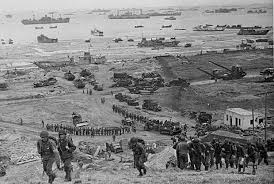Understanding D-Day: History, Meaning, and Impact


D-Day, which occurred on June 6, 1944, remains one of the most pivotal events in World War II. This historic day marked the beginning of the end for Nazi Germany as Allied forces launched a massive invasion on the beaches of Normandy, France. Known as Operation Overlord, the D-Day invasion involved meticulous planning, unprecedented coordination, and immense bravery from the soldiers who participated. The significance of D-Day extends far beyond the battlefield; it symbolizes the collective effort and sacrifices made by the Allied nations to restore peace and freedom in Europe.
The operation was a turning point in the war, as it set the stage for the liberation of Western Europe from Nazi occupation. The scale of the invasion was unprecedented, involving over 156,000 troops from the United States, the United Kingdom, Canada, and several other Allied nations. They were supported by thousands of aircraft and naval vessels, creating a formidable force that aimed to breach Hitler's Atlantic Wall defenses.
D-Day's success hinged on a combination of strategic deception, intelligence gathering, and the element of surprise. Despite facing formidable obstacles such as rough seas, fortified positions, and fierce resistance from German forces, the Allied troops managed to secure a foothold on the French coast. This achievement was not without significant casualties, but the bravery and determination displayed during the invasion laid the groundwork for subsequent operations that would ultimately lead to the defeat of Nazi Germany.
Understanding D-Day is essential for comprehending the broader narrative of World War II. It was not merely a military operation but a symbol of international cooperation and resolve. The events of June 6, 1944, continue to be studied and commemorated, reflecting their enduring impact on history and their role in shaping the modern world. This introductory overview sets the stage for a deeper exploration into the details and lasting significance of D-Day.
What Does D-Day Stand For?
The term 'D-Day' is deeply entrenched in military jargon, representing the day on which a significant combat attack or military operation is set to begin. While 'D-Day' is often associated exclusively with the events of June 6, 1944, it is, in fact, a generic term widely used by armed forces to indicate the commencement date of any major military offensive. The 'D' in 'D-Day' simply stands for 'day,' and the term is used to maintain operational security and avoid disclosing specific dates.
In military planning, the precise timing of an operation is critical. Therefore, terms like 'D-Day' and 'H-Hour' are employed to designate the start times of operations without revealing exact details prematurely. These terms provide a flexible and secure way to refer to the pivotal moments when actions are set to unfold. For instance, the days leading up to and following D-Day are often referred to as 'D-1,' 'D+1,' and so forth, indicating the days before and after the operation commences.
Despite its generic usage, the term 'D-Day' became immortalized on June 6, 1944, when Allied forces launched Operation Overlord, the largest seaborne invasion in history. This historic D-Day marked the beginning of the liberation of Western Europe from Nazi occupation during World War II. The successful landing of Allied troops on the beaches of Normandy, France, signified a turning point in the war, leading to the eventual defeat of Nazi Germany.
The significance of June 6, 1944, and its association with 'D-Day' has since overshadowed other uses of the term, embedding it into the collective memory as a symbol of courage, strategy, and international cooperation. The events of that day are commemorated annually, honoring the bravery and sacrifice of those who participated in the operation. While 'D-Day' continues to be used in military contexts, it is the legacy of the Normandy landings that has etched the term into history, making it synonymous with one of the most pivotal moments of the 20th century.
The Operation: What Was D-Day?
D-Day, which occurred on June 6, 1944, marked the beginning of Operation Overlord, the Allied invasion of Nazi-occupied France. This monumental effort aimed to establish a foothold in Western Europe, opening a Western Front against Nazi Germany and ultimately leading to the liberation of occupied territories. The planning for D-Day was extensive, involving meticulous coordination and strategic deception to mislead the German forces about the true invasion site.
The logistics behind D-Day were immense and complex. The operation involved over 156,000 Allied troops, including forces from the United States, the United Kingdom, Canada, and various other nations. These troops were supported by nearly 7,000 naval vessels and over 11,000 aircraft. The invasion targeted five key beaches along the Normandy coast, codenamed Utah, Omaha, Gold, Juno, and Sword. Each beach had specific objectives and was assigned to different Allied nationalities to ensure a coordinated assault.
The execution of D-Day began in the early hours of June 6th, with airborne operations designed to secure key positions and disrupt German communications. Paratroopers from the 82nd and 101st Airborne Divisions of the United States, along with British and Canadian airborne units, were dropped behind enemy lines. These initial efforts aimed to create confusion and pave the way for the amphibious landings.
As dawn broke, the amphibious assault commenced. The landings faced fierce resistance, particularly at Omaha Beach, where American forces encountered well-fortified German defenses. Despite the heavy casualties, the determination and bravery of the Allied troops led to the eventual securing of all five beaches. The success of these landings allowed the Allies to establish a critical beachhead, from which they could continue their advance into France and beyond.
The overall strategy of D-Day was to breach the Atlantic Wall, a formidable line of coastal defenses constructed by the Germans. The objectives were not only to secure the beaches but also to capture key towns, roads, and bridges, facilitating further advances inland. The success of D-Day was a pivotal moment in World War II, marking the beginning of the end for Nazi Germany and proving the effectiveness of Allied cooperation and planning.
The Human Cost: American Casualties on D-Day
D-Day, known as Operation Overlord, is etched in history as one of the most significant military operations of World War II. However, the success of this mission came with a significant human cost. On June 6, 1944, American forces suffered considerable casualties as they stormed the beaches of Normandy. Estimates suggest that around 2,500 American soldiers lost their lives on D-Day, with many more wounded or missing in action.
The sheer number of casualties underscores the bravery and sacrifice of these soldiers. They faced an entrenched and well-prepared German defense, including formidable obstacles, fortified positions, and relentless enemy fire. Despite these formidable challenges, American troops displayed extraordinary courage and determination. This valor was not without its price, as many soldiers paid the ultimate sacrifice in the quest to liberate Europe from Nazi occupation.
The impact of these casualties extended far beyond the battlefield. Each fallen soldier represented a grieving family and a community back home. For countless American families, the loss of a loved one on D-Day meant an enduring void. The news of the casualties reached towns and cities across the United States, bringing a wave of sorrow and reflection. The bravery of these soldiers became a testament to the nation's resolve and commitment to the cause of freedom.
Moreover, the human cost of D-Day served as a stark reminder of the sacrifices required in times of war. The stories of individual soldiers, their acts of heroism, and their ultimate sacrifices became a source of inspiration and remembrance. Memorials and commemorations have since honored their legacy, ensuring that the courage and sacrifice of these American soldiers are never forgotten.
D-Day's human cost highlights the profound impact of war on individuals and communities. The American casualties on that day stand as a poignant reminder of the price of freedom and the enduring legacy of those who gave their lives in the pursuit of a better world.
The Outcome and Impact of D-Day
The successful landing on Normandy's beaches marked a turning point in World War II, significantly altering the course of the conflict in favor of the Allied forces. The immediate outcome of D-Day was the establishment of a critical foothold in continental Europe, which allowed the Allies to launch further operations against Nazi Germany. By securing this strategic position, the Allies were able to initiate a series of offensives that would eventually lead to the liberation of Western Europe from Nazi occupation.
In the months following D-Day, the Allied forces advanced through France, culminating in the liberation of Paris in August 1944. This momentum continued as they pushed towards Germany, forcing the Axis powers into a defensive stance. The pressure created by the Western Front, coupled with the Soviet advances from the East, created a two-front war that ultimately strained German resources and hastened their defeat. The successful invasion of Normandy thus directly contributed to the eventual downfall of Nazi Germany and the end of World War II in Europe in May 1945.
Beyond its military significance, D-Day had profound geopolitical and social impacts. The operation demonstrated the strength of Allied cooperation and the effectiveness of joint military planning, reinforcing the importance of international alliances. The success of D-Day also bolstered morale among occupied populations and resistance movements across Europe, providing hope and encouraging further resistance against Nazi occupation.
Furthermore, the legacy of D-Day extends into the post-war era, influencing the geopolitical landscape of the 20th century. The collaboration among Allied nations during the invasion laid the groundwork for post-war institutions such as the United Nations and NATO, aimed at fostering international cooperation and preventing future conflicts. Socially, D-Day is remembered as a symbol of courage, sacrifice, and the collective effort to uphold freedom and democracy.
Remembering D-Day: Legacy and Commemoration
D-Day, the pivotal event that marked the beginning of the end of World War II, continues to hold a significant place in contemporary memory. Numerous memorials and ceremonies worldwide pay homage to the bravery and sacrifices of those who participated in the Normandy invasion. These commemorative efforts ensure that the legacy of D-Day remains vivid and meaningful for future generations.
One of the most prominent sites of remembrance is the Normandy American Cemetery and Memorial in France. This hallowed ground serves as the final resting place for nearly 9,400 American soldiers who gave their lives during the D-Day landings and subsequent operations. The cemetery, with its meticulously maintained lawns and rows of white crosses, is a poignant reminder of the human cost of war. Visitors often participate in guided tours, educational programs, and solemn ceremonies, such as the annual June 6th observance, to honor these fallen heroes.
In addition to physical memorials, the commemoration of D-Day extends to numerous ceremonies around the world. These ceremonies often include wreath-laying, moment of silence, and speeches by veterans and dignitaries. Nations like the United States, the United Kingdom, Canada, and France hold these events to express their gratitude and to educate the public about the significance of D-Day. Schools and universities also play a crucial role by incorporating D-Day studies into their history curricula, ensuring that students understand the event's impact on global history.
The preservation of D-Day's memory is further supported by various media, including documentaries, films, and books that recount the stories of those who lived through the invasion. These narratives not only provide historical context but also humanize the experiences of soldiers and civilians. Museums dedicated to World War II, such as the National D-Day Memorial in the United States, serve as educational hubs, offering interactive exhibits and firsthand accounts that engage visitors of all ages.
Preserving the memory of D-Day is a collective effort that involves governments, educational institutions, and individuals. By continuing to honor and remember the sacrifices made on June 6, 1944, society ensures that the profound lessons of courage, resilience, and cooperation endure across generations.


